It had been over ten years since we last visited Namibia and Botswana and this trip had been in the planning stage for three years! Finally on the 19th 0f September 2010 we set off for the Kruger National Park. Our plan was to travel north from crocodile bridge through Kruger to Punda Maria and then head East to Messina and cross into Botswana via the border post at Pont Drift.
Our first night stop was at letaba where the camp was so busy that we couldn't even get into the camp ground and had to settle for the four of us sharing one of the permanent tents. It will teach us to book in advance in future. The next day we drove the short distance to the Shipendani overnight hide where we did have a booking. The facilities are very basic just drop down beds with bedding supplied, a fenced in Braai area and a long drop loo. Not a huge amount of animal sightings but a fun experience all the same. Our final stop in Kruger was at Punda Maria where we spotted huge herds of Buffalo and the lucky sighting of a sable antelope. It had been years since we had seen this beautiful antelope in Kruger and it created so much excitement that you would have thought that we had seen a dozen Leopards.
Leaving Kruger Park we headed east, via Musina, to one of our favourite South African reserves,
S22 14 36.64 E29 24 01.90
Mapungubwe National Park.
Coming, as it was, to the end of winter, Mapungubwe was very dry and the great green greasy Limpopo was just
a grey green trickle. Close to our rondavel there was a lovely swimming pool set in the rocks overlooking a valley.
On the morning of our departure we wandered across for a last look and were totally surprised when a large elephant
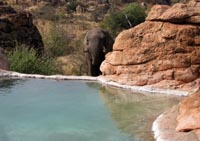 stuck his head over the end to drink from the pool. He was one of half a dozen who had come up the valley and were
awaiting their turn to drink, wonderful moments in life.
stuck his head over the end to drink from the pool. He was one of half a dozen who had come up the valley and were
awaiting their turn to drink, wonderful moments in life.
We crossed into Botswana at Pont Drift where the water level in the Limpopo being so low meant that we only had to negotiate a rather muddy hole on the SA side of the river. Formalities on the Botswana side were handled by friendly and welcoming officers who wished us a happy time in their country. It was a rather bumpy drive to the Tuli Lodge, Molema camp site where the camp manager Casablanca the owner of an amazing set of brilliant white teeth, provided us with a shady campsite under huge trees complete with our own rather basic reed shower and toilet. We spent a lazy couple of days here exploring around the area before heading north to Nata.
It was our intention to reach Nata in one day but the day got the better of us and we spent a night in Francistown at the camp site in the grounds of the Cresta Marang hotel, our fourth time there, a useful transit stopover.
The camp site at the Nata Lodge is sandy and dusty but on the plus side there is a nice swimming pool
and an excellent restaurant.  The swimming pool was definitely needed as the temperature was now in the low forties.
The day that we visited the Nata bird sanctuary S20 17 15.08, E26 17 57.92 on the Makgadikgadi pans was very windy and as dry as a bone.
The dust was a major hindrance to the enjoyment of the sanctuary. The views of the pan are amazing but we only
managed a few minutes on the lookout platform before we had to seek sanctuary back in the Land Rover.
The only water to be seen was in a few pools at the river mouth
The swimming pool was definitely needed as the temperature was now in the low forties.
The day that we visited the Nata bird sanctuary S20 17 15.08, E26 17 57.92 on the Makgadikgadi pans was very windy and as dry as a bone.
The dust was a major hindrance to the enjoyment of the sanctuary. The views of the pan are amazing but we only
managed a few minutes on the lookout platform before we had to seek sanctuary back in the Land Rover.
The only water to be seen was in a few pools at the river mouth 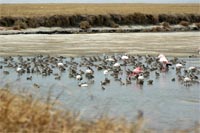 which were full of ducks, flamingos and waders.
which were full of ducks, flamingos and waders.
We headed north for Kasane, on the A33 a road so very badly potholed that after 200k's of taking avoiding action and when coming upon, by chance, a small lodge called "A Touch of Africa" S18 30 10, E25 36 14.1 the decision was taken to stay in a cottage and enjoy a touch of luxury. A nice little water hole on the property with a viewing platform provided some interesting birdwatching, Pearl Spotted owl, Shikra, huge flocks of Red-billed Quelea, Loads of White-browed Sparrow-weavers amongst others. In the afternoon, at the suggestion of Kurt our host, we drove the old Hunters road for about 25k's along the border with Zimbabwe to Kazuma Pan S18 22 36.8, E25 31 04.9 where we had some excellent elephant activity. It would have been nice to spend another day there but we had a schedule to keep up with.
30th September, it was only a short drive to the Kasane where we camped one night at Thebes camp and the
following two nights at the Chobe River Lodge. Kasane was a great deal busier than when we were last there about
ten years back, then it was a quiet backwater, these days it is bustling with tourists and safari trucks.
On our second evening we took a trip on the river and were lucky to get on a small boat, only ten of us,
it brought back many memories for us pottering along as the sun went down and the shadows lengthened , wonderful
sightings of Elephant coming down to drink in the fading light.
was a quiet backwater, these days it is bustling with tourists and safari trucks.
On our second evening we took a trip on the river and were lucky to get on a small boat, only ten of us,
it brought back many memories for us pottering along as the sun went down and the shadows lengthened , wonderful
sightings of Elephant coming down to drink in the fading light.
The next day our friends Rich and Gill took the bus over to Victoria Falls while we spent the day getting Badger ready and purchasing food and drink and paying our park fees for Chobe and Savuti National parks. Heavens the parks have got expensive, apart from daily fees the camping is now about fifty $US per night each! And you don't get much for your money, are they trying to discourage independent travel or what?
The roads in the parks in Botswana do not receive even basic maintenance it's Land Rover heaven and Badger was in his element. The driving to say the least was at times challenging, long stretches of deep sand and a lot of low gear work
Our first night camp was Ihaha, just a basic ablution block and a dusty camping pitch, no 8
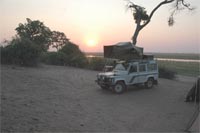 S17 50 19.29, E24 52 38.36
but the peace and quiet, priceless! Just before nightfall we took
a drive along the river and were amazed to see huge numbers of Elephant and a herd of Buffalo that we estimated
to be about two thousand in strong. A sign at the entrance to the camp says zip up your tent and not to emerge
until dawn, we zipped up tight.
S17 50 19.29, E24 52 38.36
but the peace and quiet, priceless! Just before nightfall we took
a drive along the river and were amazed to see huge numbers of Elephant and a herd of Buffalo that we estimated
to be about two thousand in strong. A sign at the entrance to the camp says zip up your tent and not to emerge
until dawn, we zipped up tight.
Early next morning refreshed from a good nights sleep we packed camp and set off for Savuti. Driving along the river we experienced some wonderful encounters with Elephants. In places you could have reached out and touched them as we drove past. Coming around one corner we surprised one large female with the smallest calf that we had ever seen, probably only a day or two old, as we drove by we were only a few metres from her, luckily she reacted by turning away into the bush, it makes your heart pound. At one point we witnessed thousands of migrating Carmine Bee-eaters arriving from the north. Most marvellous of all were sizeable groups of Sable and Roan antelope, our first for a long time.
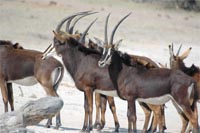
We drove out of Chobe on a forest road to Savuti quite a reasonable road compared to the park roads, unfortunately for the last 20k's or so we had the choice of two roads and picked the wrong one. 18k's of the worst driving for years! Arriving at the Ghoha gate the Ranger who booked us in remarked "I think you took a bad road" what an understatement! S18 23 14.63, E24 14 44.21
Savuti camp is situated on the edge of the Savuti channel. S18 34 01.66, E24 03 54.59This river hasn't flowed for the past twenty years however for the last two it has been in full flood. To get to the camp we had to cross the channel, the water was not to deep just over wheel height but loose rock meant Badger did quite a bit of slipping and sliding on his way across. The camp at Savuti is very sandy and the ablutions are reasonable, nice big camp sites. The big disappointment was the lack of animals. Savuti is known for its animals coming into the camp. The locals were saying that it was because the river was flowing again.
Our plan from here was to drive to Kwai cross the river there and enter Moremi through North gate. We got into discussions there and because there was so much water in the flood plains they'd had a difficult time but being three vehicles they were able to pull each other through. Their advice was that as we were only one vehicle we would be taking a risk going that route. We decided that the safe option would be to drive down to Maun and enter Moremi through South Gate.
While at Savuti we took a few drives in the area around about the camp but the sand was so deep that there was really no pleasure in it for the driver and the lack of wildlife was a real disappointment.
From Savuti we took the sand ridge road down towards Maun. On the way to the gate we had some more challenging stretches in places, deep sand and then deep potholes that had everyone's head hitting the roof.
We exited Savuti via Mbabe gate S19 06 10.18, E23 59 07.03 and I was not too sorry to leave the deep sand and the potholes behind. From this point it was 200k's or so down to Maun where we re-acquainted ourselves with Audi camp S19 56 06.90, E23 30 31.71 a very pleasant place to spend a couple of days. After a couple of relaxing days here it was time to head into the bundu again, this times Moreme and the Okavango Delta.
On the 7th of October we left Maun for Moremi on a rather badly corrugated road to South Gate
S19 25 33.30, E23 38 42.71 and them drove the fire break road, which is as straight as a ramrod, up to North Gate
S19 10 23.85, E23 45 04.80 and then travelled along edge of the swamps to Xakanaxe S19 10 52.98, E23 24 39.93
 where we were booked to
camp for the night. Some 17k's or so from North gate we came to a water crossing, we had
been advised by the rangers at the gate that this was the only one and the water level was dropping.
Richard waded across and it seemed ok, coming up to the top of his legs so I took Badger across.
All was going well and until about two thirds of the way to the other side when he went into a hole and the
water came over the bonnet, anyway he got through ok and we stopped and had a drink while he dried out.
We had barely travelled 4k's when I noticed that the engine temperature was rising and stopped to investigate
I was shocked to discover that the water had removed all of our cooling fan blades and also knocked a
hole in the radiator! By right the viscous fan unit should have stopped this from happening and I could
only assume that because of the high ambient temperature, which was in the low 40's c, the unit had seized.
where we were booked to
camp for the night. Some 17k's or so from North gate we came to a water crossing, we had
been advised by the rangers at the gate that this was the only one and the water level was dropping.
Richard waded across and it seemed ok, coming up to the top of his legs so I took Badger across.
All was going well and until about two thirds of the way to the other side when he went into a hole and the
water came over the bonnet, anyway he got through ok and we stopped and had a drink while he dried out.
We had barely travelled 4k's when I noticed that the engine temperature was rising and stopped to investigate
I was shocked to discover that the water had removed all of our cooling fan blades and also knocked a
hole in the radiator! By right the viscous fan unit should have stopped this from happening and I could
only assume that because of the high ambient temperature, which was in the low 40's c, the unit had seized.
By driving carefully and stopping often we reached Xakanaxe camp and set up our tents. Our plan had been to spend one night here and then drive a few k's for a two night stay at third bridge but loosing our fan had changed things and after unsuccessfully exploring ways of getting a replacement fan sent to us we made the decision to stay at Xakanaxe for two days and then set of at the crack of dawn in the cool air and return to travelling in the bush. Later up in our roof tent we were woken by a loud munching and we were treated to sight of three huge hippo's just feet away while our friends had the unique experience of having their tent sprayed with Hippo dung!
Back in Maun we managed to get a new fan fitted and on checking in at Audi camp again we were delighted to learn that our first Granddaughter had arrived safely, back home in Jersey.
Our next drive was some 380k's around the edge of the delta to shakawe. About 6k's from Shakawe there is a delightful camp by the name of Drotsky's cabins S18 24 51.22, E21 53 05.55 situated right on the edge of the water it has some excellent bird watching and some really naughty monkeys who will raid your site for anything they can get their hands on.
We hired a boat to take us out on the delta, wonderful birding, dozens of Malachite and Pied Kingfisher,
African skimmer and at one point a huge breeding colony of Carmine Bee-eaters amongst many other species.
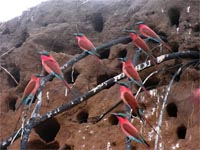 Cruising back to our camp with the setting sun behind us was an unforgettable experience. We also drove out
to the Tsodilo hills, the highest point in Botswana, we were told and an incredibly sacred place to the
people of this region. S18 45 22.97, E21 44 14.56 A guide showed us around caves and showed us rock
paintings. This was the place where the great African explorer Laurens Van der Poste made an incredible
faux-pas by killing an antelope for food without permission of the guardians.
Cruising back to our camp with the setting sun behind us was an unforgettable experience. We also drove out
to the Tsodilo hills, the highest point in Botswana, we were told and an incredibly sacred place to the
people of this region. S18 45 22.97, E21 44 14.56 A guide showed us around caves and showed us rock
paintings. This was the place where the great African explorer Laurens Van der Poste made an incredible
faux-pas by killing an antelope for food without permission of the guardians.
We crossed into Namibia at the Mohembo border post where the formalities were dealt with by quite the nicest border officers that we have encountered in all our long years of crossing borders. As we drove along the river quite by accident we discovered the Nundu Lodge with lovely secluded camp sites and being so pleasant we stayed for another three days. For the first time on this trip we were camping on a nice grassy pitch instead of dusty sand and,we had a nice swimming pool and a riverside deck where we sipped our gin and tonic while watching the most marvellous sunsets, it doesn't get any tougher!
While camped here we visited two local reserves, The Mahango reserve situated close to the border post which is quite small but has some excellent birdwatching and also the chance to see, those most beautiful of the antelope, Roan and Sable. The other is the Buffalo reserve S18 07 08.04, E21 40 42.02 which has a nice drive alongside the river for about 20 kilometres. We had some great birding here including Wattled Crane, Crimson Breasted Shrike, Collared Pratincole and Swallow Tailed Bee-Eater. There were also plentiful Elephant and Buffalo
Leaving here we travelled via Divindu a small dusty village, where we were able to stock up with a few basic provisions, to the bustling riverside town of Rundu spending the night in small bungalow at a riverside lodge. The river here is the Kavango and makes the border between Namibia and Angola. We could see across the river to a small village and it was obvious that the people of that area were very poor compared to Namibia which is quite a well off country by comparison.
On the road again, heading south, our destination Grootfontein. About fifty kilometres short of Grootfontein we discovered Roy's Camp S19 13 55.02, E18 29 59.09 a delightful quirky camp obviously put together by someone with great imagination. The bar and pool area was decorated with all manner of wood-carvings, old farm machinery, odd bric-a-brac and furniture made from logs and animal horns we decided that a thee night stop was in order. There were some nice walking trails that we enjoyed and from the bar in the evenings we could watch Eland and Duiker come to drink at the waterhole.
On our second morning at Roy's we set off early and drove about 80k's to Bushmanland to what had been described
to us as a living museum of the san Bushmen. We arrived at their village S19 16 56.18, E19 12 18.88 and were
greeted by a young girl who described several activities that we could take part in; we opted for a walk in the bush.
she then asked us to drive a few hundred meters to their camp site where we would be met for the walk. At the
appointed spot, under a large Shady tree, 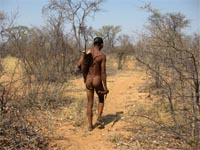 a small Bushman was waiting for us dressed in simple leather loin cloth
with a leather bag slung over his shoulder containing his bow and arrows an axe and various other bits and bobs.
The young girl who'd met us before and spoke excellent English now re-joined us only now instead of tee shirt and
shorts it was just a little leather skirt. We walked with the two of them to a small encampment where we met other
San and after a demonstration how to make fire by rubbing sticks together we were joined by another girl and set
off for our walk. Our guide who was also a medicine man explained as we went along how they found water and how
they hunted with bow and poisoned arrows. We were really impressed with his enthusiasm. As we made our way our
guide kept up a non stop conversation in his amazing click language and every few yards he would stop to describe
a medicinal plants or to dig up various roots and all the while the young girl, would interpret for him,
it was fascinating to learn a little of their fast disappearing way of life. When they were free to roam these
friendly souls lived at one with nature only taking what they needed and protecting their environment. Now that
they are no longer allowed to roam freely one can't help feeling sorry for them reduced to entertaining
tourists like us!
a small Bushman was waiting for us dressed in simple leather loin cloth
with a leather bag slung over his shoulder containing his bow and arrows an axe and various other bits and bobs.
The young girl who'd met us before and spoke excellent English now re-joined us only now instead of tee shirt and
shorts it was just a little leather skirt. We walked with the two of them to a small encampment where we met other
San and after a demonstration how to make fire by rubbing sticks together we were joined by another girl and set
off for our walk. Our guide who was also a medicine man explained as we went along how they found water and how
they hunted with bow and poisoned arrows. We were really impressed with his enthusiasm. As we made our way our
guide kept up a non stop conversation in his amazing click language and every few yards he would stop to describe
a medicinal plants or to dig up various roots and all the while the young girl, would interpret for him,
it was fascinating to learn a little of their fast disappearing way of life. When they were free to roam these
friendly souls lived at one with nature only taking what they needed and protecting their environment. Now that
they are no longer allowed to roam freely one can't help feeling sorry for them reduced to entertaining
tourists like us!
Thursday 21st of October time to move on
The town of Tsumeb is a small copper mining town about 100k's south east of Etosha National Park. Here we needed to restock our food supplies and so camped at the town municipal campsite. This turned out to have been completely revamped since our last visit some eleven years back and now boasts an Olympic sized swimming pool. While in Tsumeb we visited the two amazing lakes, Lake Otjikote and Lake Guinas these lakes were actually once underground caves, part of an underground river system, the roofs of the caves collapsed leaving two extremely deep lakes. Driving back to Tsumeb I noticed that our charging system was malfunctioning. Being Saturday the auto electrical businesses in town were closed for the weekend but we were fortunate in finding an engineer, out of town, in the industrial area and still open. He confirmed that one of our batteries was dead and as luck would have it was able to let us have a replacement. We had been extremely lucky as the following day, Sunday; we had booked accommodation for six days in Etosha national Park.
We left Tsumeb early in the morning and arrived at Namutoni gate, which is at the S18 48 35.65, E16 56 27.67
.Eastern 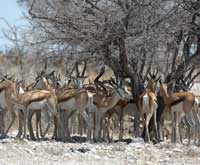 end of the Etosha National Park at 9.45. And from thereon we enjoyed six days in the park camping for two days at
each of the three camps, Namuntoni, Halali and Okauuejo in that order. Each camp has a floodlit waterhole and a
swimming pool so with it being so hot our usual day started with an early game drive then getting back to camp around
midday for lunch and a swim then an evening drive, dinner and then off to the camp waterhole with our coffee mugs,
we struggled.
end of the Etosha National Park at 9.45. And from thereon we enjoyed six days in the park camping for two days at
each of the three camps, Namuntoni, Halali and Okauuejo in that order. Each camp has a floodlit waterhole and a
swimming pool so with it being so hot our usual day started with an early game drive then getting back to camp around
midday for lunch and a swim then an evening drive, dinner and then off to the camp waterhole with our coffee mugs,
we struggled.
The sightings in Etosha were excellent huge numbers of Zebra, Kudu, Giraffe, Wildebeest, Dik-Dik; Black faced Impala (unique to Etosha) Eland and many more. At the waterholes we were getting as many as five Black Rhino at a time. We also saw twenty five lions in various places, the largest group being a pride of fifteen. We had six great days of animal and bird watching, swimming, eating and just enjoying and our bird count at the moment is up to 240 species. After Etosha we drove down south for about a hundred k's to the small town of Outjo and did some food shopping and then drove to the small town of Kamanjab. Jan had read in her travel guide about a Farm near there that had an informal Cheetah sanctuary.
S19 36 22.57, E15 04 10.76,
Otjitotongwe Cheetah farm, run by Tollie and Roeleen Nel, turned out to be a real gem,
it has a very rustic bush camp site but it had all that we needed including plenty of shady trees. At four in the
afternoon nine of us climbed into the back of a pick-up. In the UK, health and safety would have had a fit if they
had seen us. Firstly we were taken to the farm house where they had three tame cheetahs, rescued as cubs and raised
with the family.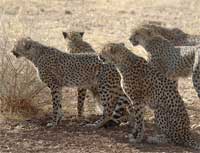 By this time we had been joined by another group from an overland truck and spent the next
half-hour or so petting and playing with these Tame Cheetahs who just wandered amongst us and enjoyed licking the
salt off our skin with their extremely scratchy tongues. One of them had a thing about shoes and would suddenly
grab someone's shoe, so one of the Tollie's son's would quickly unlatch the animal before he could get the shoe
off. There was also a rescued Giraffe, about three years old, he was quite a character and wasn't at all fazed
By this time we had been joined by another group from an overland truck and spent the next
half-hour or so petting and playing with these Tame Cheetahs who just wandered amongst us and enjoyed licking the
salt off our skin with their extremely scratchy tongues. One of them had a thing about shoes and would suddenly
grab someone's shoe, so one of the Tollie's son's would quickly unlatch the animal before he could get the shoe
off. There was also a rescued Giraffe, about three years old, he was quite a character and wasn't at all fazed
by people in fact he took an active interest in everyone and would lower his face down to your eye level to have his
nose scratched. After the tame Cheetahs we climbed back into the pick-up and drove out to a huge enclosure of many
acres that at that time held seventeen wild cheetahs mostly rescued from farmers who in other-times would have shot
them. It was explained that it was necessary to hand feed them because if they enclosed antelope in with them as prey
animals the cheetahs wouldn't just hunt them  when hungry they would kill them all in short order as cheetah's will
kill out of instinct. The Cheetah's gathered around our vehicle and lumps of meat were thrown to them. Each animal
got his or her share and went off into the bush to eat. It was a nice informal way to see the Cheetah's.
We were joking on the way back to camp, bouncing around in the back of the truck that if it had been in UK we would
have been required to where belts, helmets, reflective jackets and goggles and stand fifty yards back behind a fence!
when hungry they would kill them all in short order as cheetah's will
kill out of instinct. The Cheetah's gathered around our vehicle and lumps of meat were thrown to them. Each animal
got his or her share and went off into the bush to eat. It was a nice informal way to see the Cheetah's.
We were joking on the way back to camp, bouncing around in the back of the truck that if it had been in UK we would
have been required to where belts, helmets, reflective jackets and goggles and stand fifty yards back behind a fence!
Next morning we upped sticks and on the way out paid our bill at the farm house. While doing so the giraffe wandered over and started pulling things off the roof rack and then tried to get his head in through the car window, but he was such a gentle creature that you really couldn't be cross with him. From Kamanjab we headed east on a rather bumpy road and via a rather spectacular mountain pass to a Palmwag. S19 53 08.60, E13 56 12.26
Palmwag is a palm fringed Oasis set in hilly desert the lodge and camp site are situated on the banks of the dry
Uniab River. Here we had one of our nicest camp sites so far. We had our own reed enclosed toilet, shower a kitchen
area and shady Lapa plus a wonderful view across a dry river bed to the hills beyond. At night the desert Elephants
were munching away in the reeds just twenty feet from our tent. While at Palmwag we had a ten kilometre walk. Geeson,
our guide was very knowledgeable and took us close to Hartmann's mountain Zebra, Springbok and Oryx. The river which
apart from a few pools was completely dry, 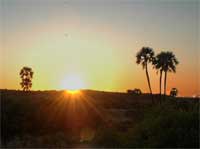 the rains are not expected until around the end of December. Coming back
to camp we had to pass an Elephant grazing in the river bed which had Geeson more than a little worried for our safety.
the rains are not expected until around the end of December. Coming back
to camp we had to pass an Elephant grazing in the river bed which had Geeson more than a little worried for our safety.
Leaving Palmwag early in the morning S19 07 31.17, E13 37 00.03 we drove North to Sesfontein, approximately 100k's of
rather nasty road but wonderful mountain scenery, along the way we spotted Mountain Zebra and Elephant and we even had
a black rhino cross the road in front of us. It really is wonderful to see these truly wild unfenced desert animals.
We met Keefas, our guide, at the general store. Our plan was for Keefas to take us to visit a local Himba village.
We purchased a whole load of staple foods such as Maize flour, cooking oil, Tea and lots of other bits, Oh, and
including Vaseline which they like for their skin. We had been told that this was better than giving money.
We visited a Himba settlement about 20 kilometres from Sesfontein. There were only women and children, the men
were off with the cattle. We have seen loads of photos of these people but to meet them dressed in there amazing
clothes and decorations is really very impressive.
 The provisions sparked off a
lot of chatter and were closely inspected. Keefas had to interpret for us as they do not speak any English. The women displayed some interesting
craft work. Although the asking prices were quite high we brought several items, they have so little and you don't
come all this was to haggle over a few bob. Keefas now said that if we paid them another hundred and fifty Rand
that they would dance for us but we put our foot down and said that we had spent quite enough for one day.
After a short pause while he spoke to the women Keefas now said that because we had been so generous they would
dance for free, I rather think it may have been the large pot of Vaseline that did it. Some very energetic
dancing followed accompanied by a lot of noise and much to their amusement Janet joined in and had a go as well.
That night we camped at the Camel Top campsite. Three kilometres north of Sesfontein, it was very basic, very hot
and very dusty. We were running a bit short on food as there was not a lot available locally but the girls
managed to rustle up very nice Tuna pasta.
The provisions sparked off a
lot of chatter and were closely inspected. Keefas had to interpret for us as they do not speak any English. The women displayed some interesting
craft work. Although the asking prices were quite high we brought several items, they have so little and you don't
come all this was to haggle over a few bob. Keefas now said that if we paid them another hundred and fifty Rand
that they would dance for us but we put our foot down and said that we had spent quite enough for one day.
After a short pause while he spoke to the women Keefas now said that because we had been so generous they would
dance for free, I rather think it may have been the large pot of Vaseline that did it. Some very energetic
dancing followed accompanied by a lot of noise and much to their amusement Janet joined in and had a go as well.
That night we camped at the Camel Top campsite. Three kilometres north of Sesfontein, it was very basic, very hot
and very dusty. We were running a bit short on food as there was not a lot available locally but the girls
managed to rustle up very nice Tuna pasta.
The next morning we made a really early start for a long drive back down south via Palmwag to Twyflefontein where we were intending to camp for one night. We hadn't gone more than a few k's when we had a puncture in one of our rear tyres. After changing the wheel we set off once more. At the next village seeing a sign for tyre repairs we stopped and asked the guy in the little shack that the sign was attached to if he would repair our tyre. He said he had to go and get his equipment and returned a few minutes later with one tyre plug and a dried up tube of adhesive, things didn't look promising. We had a tyre repair kit in the Landy so let him have that. It now took him with the help of another chap three goes to stop the leak, I could have done a better job myself, you live and learn. One of the blokes had a nasty injury around his eye and told us that he had been in a car accident the previous week so Jan gave him some antiseptic cream. I wasn't happy with the repair and decided to stop at Palmwag. At Palmwag they have a fully equipped workshop. Their tyre man took one look at the botched job, sucked a lot of air through his teeth and set to work by firstly, pulling out the three botched plugs with his teeth! In short order he then got the tyre off the rim and fitted an internal gaiter, it pays to find the right bloke. Late in the afternoon we arrived at Twyflefontein and camped at Aba Huab the local community run site.
The next morning after visiting a few of the local landmarks we headed South to the small town of Uis, this was formerly a tin mining town but the mine closed down a good few years back and now the town relies on tourism. We spent the night at the quirky, German run Brandenburg guest house, where we were made very welcome. It was a luxury to sleep in a bed again, if only for one night. They also had a huge swimming pool but rather oddly the restaurant served only one course meals!
The next day we drove to the coast and the big city of Swakopmund. We camped at the Sophia Dale camp site about 12ks from the town and the temperature had dropped by about thirty degrees, from scorchio to freezio.
We spent the next four days at the oddly named, Sophia Dale camp S22 38 31.30, E14 38 10.97 about twelve kilometres out of town. We needed to get the fridge repaired and the only firm capable of doing the job was closed for the weekend, still, it gave us the chance to relax and explore Swakopmund town and Walvis Bay. Walvis Bay has a huge lagoon inhabited by thousands of Flamingos and other assorted sea birds.
After the heat of the desert we found the night temperature in Swakopmund very cold and in the evenings we needed sweaters and trousers and a big roaring fire. On Monday morning we managed to get our fridge repaired and then collected our permits from parks board to drive the Namib-Desert Park.
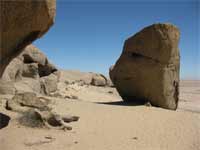
The following morning we drove to Walvis Bay and entered the Naukluft desert. The drive through the desert is beautiful and very peaceful the roads are not too bad and by the middle of the afternoon we had arrived at Homeb S23 38 11.74, E15 10 54.52 a camp site set in a dry river bed in a rocky canyon where we would spend the night. The geology of the canyon was fascinating lots of Quartz and Mica. The camp site was very dusty and when the wind blew the air, including us, glittered with Mica. There was a small African farm a few hundred metres away and we had a constant stream of goats and cows wandering through the camp, one cow even tried to eat bits of the tent. With its smelly long drop toilet this wasn't one of the most pleasant night stops. We climbed to the top of the definitely made it a worthwhile stop over. The next morning we had a lovely drive through the rest of the conservancy to the little town of Solitaire where we camped in the most delightful lodge camp with some of the most stunning scenery you could imagine. At this camp we had our own Lapa to shade us and our own shower, toilet and washroom. The lodge also had two swimming pools and a restaurant, sheer luxury after Homeb! A very cheeky tame Springbok was hanging around the camp who, if not watched would get up to all kinds of mischief; she had even learned how to undo zips with her teeth. Richard caught her opening our cool bag hoping to find food. That evening we again climbed a nearby hill to watch the sunset before enjoying an excellent meal in the restaurant, two nights, and two extremes!
The next day we drove to Sesriem S24 29 11.86, E15 48 03.91 one of the most photographed places in the world.
 The Sossusvlei dunes with their
gracefully curving ridges seen at sunset or dawn are stunning. We camped at the
parks board camp site and then in the afternoon drove the 65 kilometres into the dune field to witness the fabulous
colour changes as the sun went down. Jan and Gill climbed halfway up Dune no 45, the only dune you are allowed to
climb, it's a very steep climb that I a shied away from doing as my knee was not very good at that time.
The Sossusvlei dunes with their
gracefully curving ridges seen at sunset or dawn are stunning. We camped at the
parks board camp site and then in the afternoon drove the 65 kilometres into the dune field to witness the fabulous
colour changes as the sun went down. Jan and Gill climbed halfway up Dune no 45, the only dune you are allowed to
climb, it's a very steep climb that I a shied away from doing as my knee was not very good at that time.
The next day Friday the 12th of November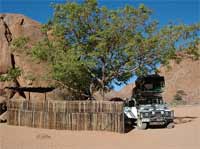 we drove to The Koiimasis Ranch a place that Jan had discovered in her
guide book. S25 55 14.20, E16 15 47.74The camp ranch and camp site was situated 20 kilometres from the main road,
not many people have a twenty k's driveway! There we discovered a farm nestling in a valley under a huge cliff
face and the most luxurious, beautiful and secluded campsite. Sadly time was against us or we would have spent a
couple of days there enjoying the peace and beautiful surroundings.
we drove to The Koiimasis Ranch a place that Jan had discovered in her
guide book. S25 55 14.20, E16 15 47.74The camp ranch and camp site was situated 20 kilometres from the main road,
not many people have a twenty k's driveway! There we discovered a farm nestling in a valley under a huge cliff
face and the most luxurious, beautiful and secluded campsite. Sadly time was against us or we would have spent a
couple of days there enjoying the peace and beautiful surroundings.
On the road again this time to the Quiver tree forest camp at the town of Keetsmanshoop for an overnight stop before driving to the Fish River Canyon.
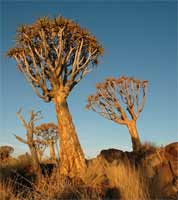
We drove first to the viewing sites at the top of the Canyon for spectacular views of the landscape then a long drive down into the canyon to Ai-Ais S27 55 20.05, E17 29 23.76 where we camped for the night and enjoyed the naturally heated spa and swimming pool. This was our last stop in Namibia. The following morning we crossed back into South Africa and overnighted in Upington at a nice Bed and Breakfast by the river and then spent two nights in the Kgalagadi Trans-frontier Reserve S26 28 26.11, E2036 47.31(formerly the Gemsbok National Park)camping at the Twee Rivieren camp. The Reserve is a lovely place and for us, full of memories, lots of red sand-dunes and interesting drives along the dry river beds. Jan and I fulfilled a long held wish when we saw a family of Meerkats in the wild for the first time; it was a real thrill for us all to see these diminutive little characters going about their daily lives. Leaving Kgalagadi Trans-frontier Park we over-nighted in Kuruman and Pretoria arriving back at Kruger Park on Saturday 20th November, in nine weeks we'd driven over 11,000 kilometres and had seen some of the most extraordinary places in southern Africa while enjoying so many wonderful experiences.
Back home in Marloth Park it took us a whole day to clean the dust and muck out of poor old Badger, he'd certainly earned a nice long rest.
